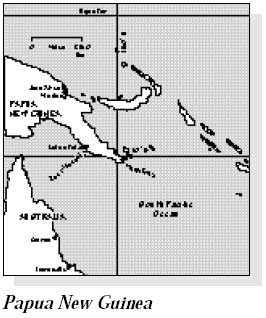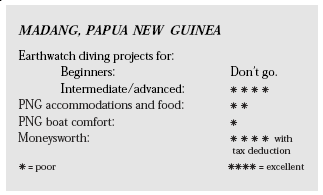Worldwide Diving, With an IRS SubsidyContents of this Issue: Worldwide Diving, With an IRS Subsidy Saving the Reefs with a Government Subsidy Anthony’s Key, Inn of the Last Resort Multiday Diving and Deep Safety Stops Gay Divers: Grand Cayman says “Stay Home” Does the Bunny Have the Best Alkaline Battery? Editorial Office: Ben Davison Publisher and Editor Undercurrent 3020 Bridgeway, Suite 102 Sausalito, CA 94965 Barracuda watching in PNG from the February, 1998 issue of Undercurrent
Dear Fellow Diver, I've learned how to get great diving, save the planet, and, at tax time, deduct everything from the cost of airfare to airfills. Here is my tale, albeit a cautionary one. Having made several enjoyable diving trips with Earthwatch, I leaped at the chance to join a new project in Papua New Guinea to study barracuda. Earthwatch, based in Watertown, MA, is the largest of many research organizations in which volunteers can participate in the collection of scientific data. You pay your way, but in return you get the satisfaction of functioning as a scientific assistant, experiencing the milieu in which the project is undertaken and deducting all your expenses from your federal and state taxes. You see, this qualifies as a legitimate contribution to a nonprofit, 501 c3 organization, as defined by the Internal Revenue Service. As anyone familiar with institutionally financed research might guess, living conditions are usually on the primitive side. In PNG, on the picturesque shores of Madang Lagoon, sits the Christensen Research Institute, a collection of buildings with a lab, study facilities, housing units and a large community room/kitchen. The saving grace is that the Institute is next to the lovely Jais Aban diving resort, originally owned by the Christensen family who established the institute "to increase Papua New Guinea knowledge of natural resources." My partner and I had a large room with comfortable
beds, a cold water basin and ample storage space; men and
women had separate but equal bathrooms, with toilet and
shower facilities. Jais Aben diving facilities were only a
few steps from our room. We made periodic shopping trips
into Madang for groceries so we could prepare individual
meals in the community kitchen. Our team consisted of my partner and me (divers of many years' experience), an enthusiastic and vigorous 17-year-old (The Kid), and a middle-aged couple (The Husband and Wife) with limited experience with resort diving. We had come to help observe "Social Behavior of Sympatric Barracuda Species," and our diving duties were quite simple -- record all barracuda sightings, including the species, number, location, depth, etc. on plastic diving cuffs. The project was directed by Shane Patterson, the Principal Investigator from the University of Georgia. A genial and delightful conversationalist, his leadership style was fluid, to say the least, so that he often seemed pervasively resistant to explicit planning and organization. We had to be prepared for sudden and unpredict- able changes of plans in ways that could be disconcerting and irritating, but ultimately possible to take in one's stride. After all, it was his research project. His goal is to get the maximum bang -- i.e., data -- for his limited bucks. While it would make sense for the PI to keep the volunteers happy with their lot, his major interest is his own research, rather than entertaining and cosseting of volunteers. Bye Bye BC Diving was from a 18-foot open skiff, back rolling into the water and, for egress, bouncing up the side of the boat. We were assisted into the boat by the divemaster, a bright, competent and experienced young American, Cliff Haugan, whose only possible flaw was a tendency not to suffer fools gladly. Trouble erupted almost immediately. On the checkout dive, the Husband chose to don his equipment in the water. After setting up his tank and BC, he tossed it loftily over the side of the boat. But, he had neglected to inflate his BC. Down it shot, narrowly missing the wreck of the B25 bomber some 85 feet below. O.K., so accidents happen. The divemaster naturally retrieved it, but the Husband then accused him of having set up the whole incident. Then, the Wife complained that the divemaster had not adequately secured her weight belt. The divemaster was not a happy camper! Things went from bad to worse when the divemaster discovered the Husband attempting to remove portions of the wreck as souvenirs and the Wife sitting on a coral head. Each participant had been sent a detailed briefing pamphlet containing an abstract of the project, the research plan and the field logistics. So, team members should have a clue about the requirements of an ecologically oriented project. Nonetheless, the Husband denounced the "insolence" of the Divemaster and swore to make no further dives with the Earthwatch group. All this was pretty awkward, since seven prepaid days of research diving remained and we were all living in adjacent rooms and, more or less, eating together. The Husband announced that he and his wife would make future dives (and buy future meals) with the resort and for the most part, avoided speaking to the project personnel. Faxes and emails buzzed back and forth to arthwatch, and although the Wife and the divemaster achieved a fragile reconciliation (and the Wife dutifully recorded all her barracuda sightings) we remained separate but equal to the end. Superb Snorkeling Meanwhile, my partner and I and the Kid enjoyed the magnificent diving of Madang Lagoon! The Kid was seldom out of the water, snorkeling around during much of our time off and exercising his sharp eyes to discover wonders in the mud. The first day he spotted three seahorses - I threw on a mask and dashed down to join him. Next he discovered a mantis shrimp, then a juvenile stonefish. He found a creature no one could identify, like a cross between a flying gunard and a pipefish. The P.I. took its picture and promised future identification. The shallow coral heads astonished me with a luxuriance and variety of marine life; swarms of blue-green chromis, dozens of rainbow shaded anthias, a variety of colorful damselfish, nine kinds of butterflyfish, four kinds of angelfish ... triggerfish ... pairs of big foxfaces ... solitary great barracuda ... anemone colonies with clownfish. In fact, Madang Lagoon is famous for the number and variety of its anemone-and-clownfish species, and an enormous variety of nudibranchs. Generally we made two or three dives a day, the first 90-110 feet on the outer edge of the fringing reef, followed by shallower dives, usually in more protected areas. We used aluminum 80's from Jais Aben. Water temperature hovered around 80 degrees F. and visibliity varied on each dive, but averaged 80 feet. Given the multiple channels, cuts and islands of Madang Lagoon, currents
are often a major challenge. Since our goal was to find barracuda, we selected
areas with stronger currents. Typically, we would anchor over the reef
near a cut through which we could reach the outer side and often we had a
struggle to get to the edge, but once down the wall the current would largely
disappear. Barracuda Point, a coral point dropping off sharply, turned out to be nearly current-free. I dropped to 50 feet, where an anemone some 25 feet square was home to dozens of pairs of clownfish. A school of sweetlips hung out nearby, but nary a barracuda. We moved to the corner of the point, where a current began to make swimming more laborious. Two two fair-sized blacktip sharks hovered there, but still no barracuda. A dive on the ill-fated B25 Bomber was noteworthy for the number and size of seafans, sponges and brilliant red soft corals. Wreck buffs could enjoy examining the residual guns and ammunition on the plane from which two crew members had originally managed to escape during WW2 only to be executed by the Japanese when they reached the shore. Four batfish drifted in and about the fuselage and a school of pennantfish cruised by. We chose Pig Bay for our shallow and relaxed later dives. In 15 feet of water I saw swarms of juvenile barracuda, a sort of nursery! I found many lionfish and a patient crocodile fish on the sand allowed himself to be thoroughly videoed. Six dolphins swerved from the ocean, turned on their sides to eye us, then they moved quickly out of camera range. Indeed, diving in Madang Lagoon was as rewarding as I'd hoped for. If you're not inclined to join the Earthwatch Brigade, Jais Aben resort is a fine place for a diving sojourn. We ate several meals in their dining-room on the edge of the lagoon surrounded by ancient coconut and breadfruit trees. Dinners -- sweet-and-sour pork, mackerel and steak -- were delicious. Also spent one night in a Jais Aben cabin by the water and had no complaints there. The Jais Aben dive operation, unlike our Spartan setup, had a 27-foot, covered boat with both a sunshade and a ladder for climbing up from the water. Divers using the operation spoke well of them. The tariff: room, three meals and two dives a day - about $140/per person. A real bargain. So...Don't do an Earthwatch trip if your goals and expectations are mainly recreational .... if your tolerance for supervision is threadbare and your humility is scant .... if you wish for service, luxury and catering. But if you don't mind roughing it, want to take a shot at saving the planet, and, at tax time, deduct everything from the cost of airfare to airfills, it's indeed a rewarding experience.
X.A |

I want to get all the stories! Tell me how I can become an Undercurrent Online Member and get online access to all the articles of Undercurrent as well as thousands of first hand reports on dive operations world-wide
| Home | Online Members Area | My Account |
Login
|
Join
|
| Travel Index |
Dive Resort & Liveaboard Reviews
|
Featured Reports
|
Recent
Issues
|
Back Issues
|
|
Dive Gear
Index
|
Health/Safety Index
|
Environment & Misc.
Index
|
Seasonal Planner
|
Blogs
|
Free Articles
|
Book Picks
|
News
|
|
Special Offers
|
RSS
|
FAQ
|
About Us
|
Contact Us
|
Links
|
3020 Bridgeway, Ste 102, Sausalito, Ca 94965
All rights reserved.

 While liquor was forbidden in the Institute, it was a short walk to
the Jais Aben bar and dining-room where,
for example, local beer ran about
$2/bottle.
While liquor was forbidden in the Institute, it was a short walk to
the Jais Aben bar and dining-room where,
for example, local beer ran about
$2/bottle. At Sek, Magic and Rasch Passages we found schools of barracuda,
a whitetip shark, several blacktips
and a variety of large pelagics.
At Planet Rock, an open ocean
seamount starting at 20 feet, I
swam with a bewildering number of
reef fish (including bannerfish,
omnipresent Moorish Idols, Rock
Cods and a coral trout with black
splotches, yellow patches and the
intriguing name of "Chinese
Footballer"), schools of jacks --
and barracuda.
At Sek, Magic and Rasch Passages we found schools of barracuda,
a whitetip shark, several blacktips
and a variety of large pelagics.
At Planet Rock, an open ocean
seamount starting at 20 feet, I
swam with a bewildering number of
reef fish (including bannerfish,
omnipresent Moorish Idols, Rock
Cods and a coral trout with black
splotches, yellow patches and the
intriguing name of "Chinese
Footballer"), schools of jacks --
and barracuda.  DIVER'S COMPASS: Costs for the Barracuda project (lodging, food,
etc.) was $1,795.00 for an 8-day session; PNG can be reached via
Manila, Singapore and Guam, or United, Quantas, and Air New
Zealand via Sydney and Air Niugini via Cairns or Brisbane, Flying
time is approximately 13 hrs LAX-SYD, then 4-5 hrs, then perhaps
an hour to Madang .... Malaria is prevalent in New Guinea, so seek
prophylaxis.
DIVER'S COMPASS: Costs for the Barracuda project (lodging, food,
etc.) was $1,795.00 for an 8-day session; PNG can be reached via
Manila, Singapore and Guam, or United, Quantas, and Air New
Zealand via Sydney and Air Niugini via Cairns or Brisbane, Flying
time is approximately 13 hrs LAX-SYD, then 4-5 hrs, then perhaps
an hour to Madang .... Malaria is prevalent in New Guinea, so seek
prophylaxis.